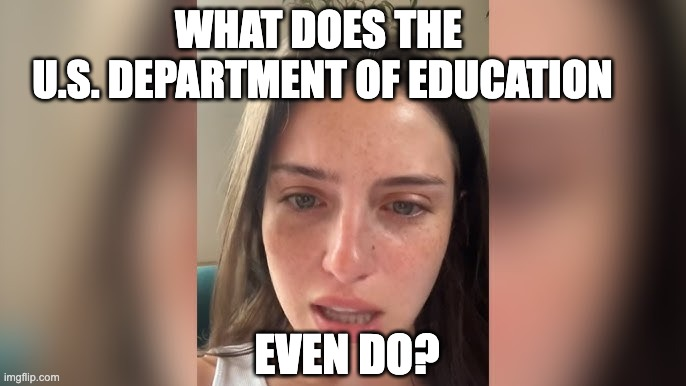What’s really at stake as we dismantle the DOE
Five days ago (March 20, 2025), President Trump signed an executive order directing Education Secretary Linda McMahon to begin the process of dismantling the U.S. Department of Education. The order aims to close the department “to the maximum extent appropriate and permitted by law” and transfer many of its functions to other agencies.
This includes moving the $1.6 trillion federal student loan portfolio to the Small Business Administration, and shifting special education and school nutrition programs to the Department of Health and Human Services. The order also prioritizes routing federal education dollars to private institutions through school choice programs, and explicitly seeks to defund initiatives that promote diversity, equity, and inclusion.
While Congress must approve any formal elimination of the department, the administration has already laid off nearly half its staff. Major lawsuits are already underway, with teachers’ unions and civil rights organizations accusing the administration of overstepping its authority. Even some Republicans—particularly those from rural districts—have raised concerns about the fallout for public schools.
Given this moment, it’s worth taking looking at what the Department of Education actually does, and what might be lost if the destruction continues unabated.

What the Department of Education Actually Does
Despite myths and political talking points, the Department of Education is not a curriculum factory or a classroom overlord. It doesn’t write textbooks, mandate what children learn, or control your local school board. Its core responsibilities are structural, protective, and financial.
Here’s what it actually does:
1. Distributes Federal Education Funding
The Department of Education allocates billions in federal funds each year, directing resources where they’re most needed:
- Title I grants help low-income K–12 schools close opportunity gaps.
- IDEA funds support students with disabilities and the services they require.
- Pell Grants provide need-based aid for low-income college students.
- Federal student loan programs—including FAFSA.
2. Enforces Civil Rights Protections
The DOE investigates violations of federal civil rights law in education—and acts on them.
In 2024, the DOE concluded that the Philadelphia School District failed to protect Jewish students from antisemitic harassment—even after repeated warnings. Students had reported Nazi salutes, swastikas, slurs, and threats, while district leaders failed to take meaningful action. Federal investigators also found evidence of retaliation against parents who complained.
The district entered a resolution agreement requiring staff training, student programming, anti-harassment policies, and improved complaint tracking—aimed at making schools safer and more accountable.
3. Collects and Publishes National Education Data
The department runs the National Center for Education Statistics (NCES), which gathers data on everything from graduation rates to achievement gaps. This data informs policy, supports research, and keeps the public informed.
4. Provides Oversight and Guidance
While it can’t dictate local decisions, the department helps schools interpret and implement federal laws like Title IX. It issues guidelines on everything from accessibility to safe learning environments.
5. Responds to Crises and Emergencies
Whether it’s a pandemic, a wildfire, or a hurricane, the Department steps in to support affected school systems. During the COVID-19 response, for example, it oversaw emergency relief funding, helped transition schools to remote learning, and worked to keep vulnerable students from falling through the cracks.
6. Holds Colleges Accountable
The department enforces accreditation standards and consumer protections in higher education—especially to prevent abuse by for-profit institutions.
During the Corinthian Colleges Scandal, the college lured in students with false job placement stats, loaded them with debt, and delivered worthless degrees. The DOE fined the college and ultimately canceled nearly $6 billion in loans for more than 560,000 students that were defrauded.
What Happens If It Disappears?
If the Department of Education is dismantled, the consequences won’t be abstract—they’ll be immediate and personal for millions of students and families:
-
Federal financial aid could collapse into chaos. I’m currently helping cover tuition for another parent’s child because their Pell Grant disbursement was delayed. Without that help, they might have had to drop out. Most students don’t have a safety net like that. Shifting the infrastructure behind FAFSA, Pell Grants, and federal loans to agencies that aren’t built for it could delay or derail critical support—right when tuition comes due.
-
Civil rights protections would weaken—or disappear completely. In states unwilling to enforce them, students could face unchecked discrimination based on race, gender, disability, and more. Without a federal watchdog, there’s no consistent floor for fairness.
-
Public schools would fall further behind. Poor and rural districts often rely on federal funding to fill gaps. Without it, already-struggling schools would be left to fend for themselves while wealthy districts surge ahead.
-
We’d lose the data we use to hold the system accountable. The Department’s national education statistics are foundational to policy, research, and transparency. Without that shared picture, we’d be flying blind.
-
Predatory colleges would have a field day. With fewer federal regulations and less oversight, for-profit institutions could once again target vulnerable students with scams and false promises—leaving them with debt and worthless degrees.
This Isn’t Hypothetical for Me
I grew up poor. Without a Pell Grant and FAFSA, I wouldn’t have gone to college. Those programs grant—and the public university system it supported—helped me go from poverty to a comfortable upper-middle-class life. This story isn’t rare. Millions of Americans rely on federal support to build a better future.
Destroying the Department of Education doesn’t just hurt “the bureaucracy.” It hurts real people. It risks throwing away the infrastructure that has helped generations climb out of poverty and into opportunity.
Let’s Be Honest About What’s Happening
You don’t have to love bureaucracy. You don’t have to agree with everything the Department of Education has done. But dismantling it isn’t about empowering parents or fixing schools—it’s about defunding protections, shifting public money into private hands, and ending federal accountability.
Rather than burning it down maybe we should consider how to improve how it serves America’s students.